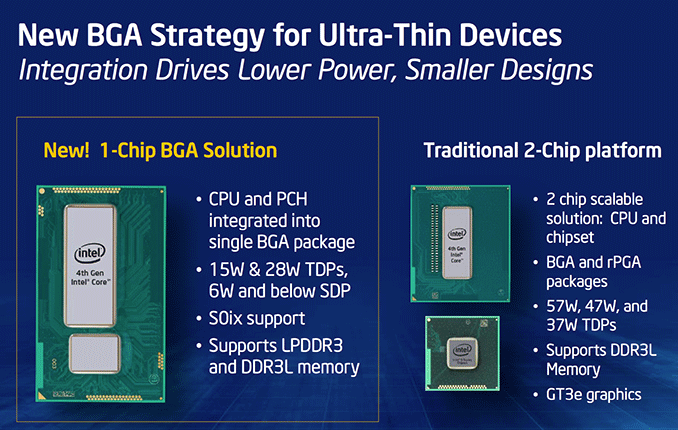The Haswell Ultrabook Review: Core i7-4500U Tested
by Anand Lal Shimpi on June 9, 2013 9:00 AM ESTOn-Package PCH, The First Single Chip Haswell
In 2010, with Clarkdale and Arrandale, Intel went from a 3-chip platform solution (CPU, IOH/MCH, ICH) down to a 2-chip platform (CPU + PCH). With Haswell, we see the first instantiation of a single-chip Core platform.
With the 8-series chipset, Intel moved from a 65nm process on the 7-series chipset to 32nm, skipping 45nm entirely. An older, less mobile-focused Intel would try to keep its chipsets on the oldest, economically sensible node possible, but these days things are different. The move to 32nm cuts TDP down considerably. Intel hasn’t publicly documented the power consumption any of its ultra mobile chipsets, but if we look at QM77 to QM87 we see a 34% decrease in TDP.
In Haswell desktop and standard voltage mobile parts, the 8-series chipset remains a an off-chip solution in a discrete package. With Haswell ULT and ULX (U and Y series SKUs), the 8-series PCH (Platform Controller Hub) moves on-package. Since it’s on-package, the TDP of the PCH is included in the overall TDP of the processor.
Bringing the PCH on-package not only saves space on the motherboard, but it also reduces the power needed to communicate with the chip. Signals no longer have to travel off die, through the package, via traces on the motherboard to the PCH. Instead you get much lower power on-package communication.
Intel also changed the interface between the CPU and PCH to a new on-package interface instead of DMI. Presumably Intel’s OPI is designed for much lower power operation.
Although PCIe support remains on the PCH (6 PCIe 2.0 lanes), there’s no external PCIe interface from the CPU itself. Any hopes for pairing a meaningfully high performance discrete GPU with Haswell ULT are dead. We didn’t see a ton of Ivy Bridge Ultrabooks with discrete GPUs, but the option simply won’t exist this time around. All of the sudden the creation of Intel’s 28W Haswell ULT with GT3 graphics makes a lot more sense. Haswell ULT lacks native VGA support. Update: NVIDIA tells me that it fully supports running a dGPU off of a x4 connection to the PCH. It's not the ideal solution, but discrete GPUs will still technically be possible with Haswell ULT.
Intel adds SDIO support. USB 3 and 6Gbps SATA are both there as well (although with fewer max ports supported compared to the desktop PCH, up to 4 and 3 respectively). There’s also a lot more sharing of bandwidth between individual PCIe lanes and USB/SATA. These limits shouldn’t be an issue given the port/drive configuration of most Ultrabooks.











87 Comments
View All Comments
Homeles - Monday, June 10, 2013 - link
Maybe you didn't catch on with Anand's "I was running this in my hotel room" statement, but the idea was to get the anxiously awaited battery life numbers out to the public.seapeople - Tuesday, June 11, 2013 - link
You mean a hotel room in Taiwan is not the normal procedure for a pedantically complete review?ciparis - Sunday, June 9, 2013 - link
OT: Opening paragraph typo: "Haswell less than a month after the arrival of a new CEO,"jhoff80 - Sunday, June 9, 2013 - link
I know you said that you disabled any Display Power Savings options in the Intel driver, but still, out of curiosity, it would be interesting to know what kind of effect those have. I mean, it wasn't made explicit, but does this specific ultrabook support Panel Self Refresh? If so, what improvements does that give?yoyoma245 - Sunday, June 9, 2013 - link
I don't understand why battery life increased going from pcmark8 home to pcmark8 creative. Wouldn't a more demanding test suite result in reduced battery life?meacupla - Sunday, June 9, 2013 - link
Could Minecraft be added to benchmarks for ultrabooks?HD5000 is obviously quite pitiful at eye candy games, so how about popular games that are most likely to be played on them?
I get around 34~40fps with surface pro, which is playable, but could be better.
esgreat - Sunday, June 9, 2013 - link
I don't think I've seen benchmarks for HD5000 yet. The i7-4500u uses HD4400 graphics.With 2x the EUs, HD5000 should give quite a performance boost, but not as fast as Iris.
krumme - Sunday, June 9, 2013 - link
Haswell U improves excactly where it was needed; on the battery life. This segment dont need more cpu power or gpu power than ib, they want battery life.This is the luxury product that ultrabooks are made for.
Haswell for the desktop was utterly unimportant, but this is excellent targeted and a very tangible improvement for everyone.
name99 - Sunday, June 9, 2013 - link
"Haswell for the desktop was utterly unimportant"Uhh, well apart from defining a rather different parallel programming model going forward...
krumme - Monday, June 10, 2013 - link
Yes. Thats relevant in perhaps 5 years from now. Perhaps. Its a technology and innovative huge step forward, but hardly of any pratical importange to the consumers today.